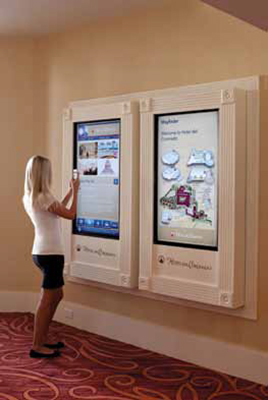Digital Signage Enters its Interactive Phase

DIGITAL SIGNAGE ENTERS ITS INTERACTIVE PHASE
Back in the day, the phone company’s message was to “reach out and touch someone.” Talk about a role reversal— with today’s increasingly interactive digital signage, now the goal is to get someone to reach out and touch the message.
“When you think about traditional digital signage, it’s all about a more effective way to ‘communicate’ with the customer,” said Gary Bailer, director of product management and information display products for Sharp. “But that communication is designed to have a message relayed to a group of people. Adding ‘interactivity’ to digital signage takes it to the next step, where it’s all about ‘engaging’ the customer. Engagement is one-to-one strategy, and as such, is more ‘sticky’ than static signage.”
Once interactivity enters the picture, AV integrators and their clients are discovering new opportunities to increase the impact of digital signage. “With the change in the way consumers are engaging with and consuming information, there has been a definite shift in expectations for interactivity in digital signage,” noted Michael O’Halloran, product marketing manager of commercial displays for Samsung Electronics America. “Consumers want to engage in a two-way exchange and access relevant information when they need it, not simply to have communications pushed out at them on digital displays.”
When you consider that consumers have become increasingly familiar with interactive applications on their smartphones, tablets, and smart TVs at home, then interactivity in digital signage emerges as a natural extension of the consumer experience.
“With today’s technology, interactivity means giving the viewer the power to control on-screen content,” noted Clark Brown, digital signage vice president for LG Electronics USA. “Interactivity can be through touchscreens where viewers can navigate simple menus for things like wayfinding and useful information, and even manipulate and create illustrations, diagrams, and more on the screen.”
That matters because interactive digital signage can create a persuasive promotional and informational platform that can be effectively deployed in retail spaces, stadiums, museums, universities, and corporate environments. Properly applied, it can encourage people to linger longer, reinforce brand loyalty, and even boost onsite sales.
A daily selection of the top stories for AV integrators, resellers and consultants. Sign up below.
As may be expected, interactivity in digital signage is hinging first and foremost on touchscreen technology—and those systems had better be good. “We see that more users aren’t just looking for a screen that displays clear and sharp resolution, but also includes touch options that provide a realistic sense of touch,” LG’s Brown said. “Based on consumer demands, LG offers highly reliable touch experiences with IR Spread technology, which is LG’s own multi-touch technology that also supports ghost-free multi-touch, and protects outdoor screens with anti-fog/anti-glare glass.”
Richard Heslett, senior product manager at Christie, observed a growing use of touch, object, and gesture recognition hardware and software— all being powered by intuitive programs to create unique and highly specialized digital content for the display. “The interactivity element can be a built-in feature,” he explained, “such as with touchpanel displays, or through third-party hardware, such as the Christie Interactivity Kit, a modular kit that can accommodate practically any large-format display up to a 12-square-meter video wall. Mobile technology is also becoming popular, with signage able to automatically connect with cell phone users to promote a product or invite their interaction through such venues as social media.”
Integrators, of course, are being asked to master yet another set of fresh offerings. In the interactive digital signage arena, LG’s Clark Brown identified two sectors that should be prioritized now. “Because touch technology is quickly becoming the norm, LG believes interactivity options will become second-nature to customers—touch digital signage monitors are becoming just as popular and expected as the telephone keypad evolving into touchscreen,” he stated. “As such, it is imperative to stay ahead of this trend, and integrators should embrace touch technology. Additionally, IPS (in-plane switching) technology is improving viewing experiences: IPS has better control of liquid crystal, which provides a viewing experience that is watchable at virtually any angle, and Ultra HD 4K panels open up new creative opportunities for integrators and program providers.”
But getting the gear right is only half the battle— knowing exactly what to display on these advanced screens also matters. “Content demands for interactive signage are much different than traditional static content,” Sharp’s Gary Bailer pointed out. “The analogy I use is similar to the difference between a great print ad versus a great website. It needs to be simple, yet engaging; active, yet easy to navigate.
“When designing content for interactive displays, care should be given to the size of the display, its orientation and mounting, and the ease of selection by the customer,” he continued. “One layout or design may not be optimal for all implementations. With interactive content, you have the opportunity to do more than just deliver information: You have the opportunity to capture information and conduct transactions. Taking advantage of these opportunities can provide the customer and integrator with valuable ROI and measurable metrics.”
Christie’s Richard Heslett noted that this type of content must also be appropriate to the venue. “Depending on the environment, that could mean drawing from numerous live sources to ensure the content is timely and relevant, such as when you’re displaying social media activity in real time,” he said. “To help better tailor the digital signage to its venue, many new technologies are emerging to manage content and maximize their impact on the screen, such as Christie JumpStart. JumpStart is an innovative, straightforward content management solution for large tiled digital displays requiring up to six video inputs. Packaged with a media server, it lets users display multiple, high-bandwidth videos and graphics from a wide range of sources on a five to 15 megapixel digital canvas—it’s an ideal companion for Christie MicroTiles.”
Another approach is to create interactive content using solutions that support the most common platforms and technologies. “For example, HTML5-based apps run on any platform or device— Android, iOS, Windows—so it’s the easiest and most widely supportive solution,” Brown said. “LG’s webOS for signage is web-centric and supports HTML5 based content, allowing for work with existing websites or partnering with content providers who can place their own software into the LG monitors for a totally customer-satisfying solution.”
Next, the source of all this rich original content is yet another piece of the puzzle—a potential revenue stream that AV specialists are incentivized to get right. “Many AV integrators have grown in-house content development services or formed strong partnerships with design and development firms to address more complex customer needs,” said Michael O’Halloran of Samsung. “When it comes to the ongoing maintenance of signage content, smaller businesses may lean on their integrator to provide a turnkey service, while larger enterprises typically delegate management to specialized on-staff resources.”
If going down into this rabbit hole seems daunting, there’s a practical impetus: wellexecuted installations can be counted on to create a positive cycle for AV integrators. “In a very real way, the higher-end interactive signage solutions sell themselves,” Heslett said. “With costs coming down, they offer more value for the money, and are being found in more and more places. Furthermore, today’s ‘cool’ new display, processor, and interactive technologies will seem old-fashioned by tomorrow, so clients should be careful to future-proof their investments. They can do this by spending a little more to get the better solution, rather than settling for a solution that just barely meets their needs and leaves no room for upgrades or enhancements.”
David Weiss (www.dwords.com) writes extensively about AV, audio, and broadcast technology.
The New Interactivity
By Maria Porco

X2O technology allows Hotel del Coronado guests to interact with signage. In today’s digital, touchscreen-powered world, people expect—and enjoy—the ability to interact with digital signage. In addition to new technologies like Microsoft Kinect, multiple-touch-point displays, small screen interactivity on mobile devices, and big-screen installations like video walls, new possibilities are rapidly unleashing innovative opportunities within today’s interactive applications. A timely example of this is near field communication (NFC), which allows the transfer of content between different devices in a seamless and powerful way.
New possibilities in the digital signage space are especially exciting for NFC. Though there are many ways for content to be transferred between a screen and a mobile device (QR codes, text, and email opt-in), NFC ushers in a new era of extraordinary convenience where simply placing the device within a few inches of the screen will trigger content transfer. Retailers can expand their promotions; hotels can increase their guest-oriented information; enterprises can empower employees with access to training; and universities can transfer information such as student schedules.
Another emerging interactive technology gaining popularity provides users with access to live video calls directly from a digital signage display. For example, last year Amazon introduced its “Mayday” service, which allows organizations to turn to signage-based video calls as a way to more effectively support customers. This new technology enables users to talk live, face-to-face with customer service personnel via any screen, in any location — opening opportunities for better collaboration in sectors such as retail, banking, manufacturing, and many more.
Maria Porco (maria.porco@barco.com) is vice president of business development for X2O Media.
